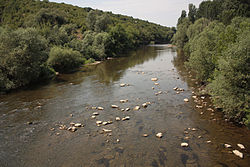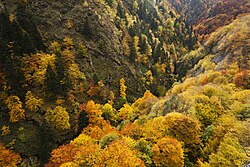Osam
 From Wikipedia - Reading time: 9 min
From Wikipedia - Reading time: 9 min
| Osam | |
|---|---|
 | |
 | |
| Location | |
| Country | Bulgaria |
| Physical characteristics | |
| Source | |
| • location | SW of Levski Peak, Balkan Mountains |
| • coordinates | 42°43′10.92″N 24°46′48″E / 42.7197000°N 24.78000°E |
| • elevation | 1,880 m (6,170 ft) |
| Mouth | |
• location | Danube |
• coordinates | 43°42′5.04″N 24°51′19.08″E / 43.7014000°N 24.8553000°E |
• elevation | 22 m (72 ft) |
| Length | 314 km (195 mi) |
| Basin size | 2,824 km2 (1,090 sq mi) |
| Basin features | |
| Progression | Danube→ Black Sea |
The Osam (Bulgarian: Осъм [ˈɔsɐm]) is a river in northern Bulgaria, a right tributary of the Danube. Its length including the main stem Cherni (Black) Osam is 314 km, making it the fifth longest river in Bulgaria. The river proper, formed by the confluence of the Cherni and Beli (White) Osam, is 278 km.[1]
Geography
[edit]Course
[edit]

The main stem the Cherni Osam is 36 km long and takes its source at an altitude of 1,880 m on the southwestern foothills of the summit of Levski (2,166 m) in the Balkan Mountains and flows north.[2] The other stem, the 28 km long Beli Osam, springs at an altitude of 1,560 m northeast of the summit of Ushite (1,637 m) in the Troyan section of the Balkan Mountains and flows northeast in a deep forested valley.[3]
The river proper forms by the confluence of the Beli Osam (left branch) and the Cherni Osam (right branch) at an altitude of 371 m in the northern outskirt of the town of Troyan. It flows north to the town of Lovech and then turns northeast until the town of Levski. In the fore-Balkan between Troyan and Aleksandrovo the Osam flows in a deep ravine-like valley. Downstream of Aleksandrovo the river enters the Danubian Plain, forming an asymmetrical valley with steeper right and gentle left slopes. From Levski the Osam's general direction is northwest. The riverbed widens and due to the small gradient meanders in all directions. In this section the riverbed is corrected with water protection dikes; the bottom changes from stony to sandy. It flows into the Danube at an altitude of 22 m between the town of Nikopol to the east and the village of Cherkovitsa to the west.[1]
Basin and hydrology
[edit]The Osam drainage basin covers a territory of 2,824 km2 or 0.35% of the Danube's total and borders the basins of the Vit to the west and the Barata and the Yantra to the east and northeast, all three of the Danube drainage, as well as the Maritsa basin to the south of the Balkan Mountain's main water divide.[1] In the Balkan Mountains the river basin is covered mainly with deciduous forests. Further north in the fore-Balkan section, the catchment area of the Osam is well forested and grassed and high-stemmed woods gradually give way to low-stemmed ones. Its main tributaries are the Shavarna (30 km),[4] and the Lomya (39 km).[5]
The Osam has a mixed feed of snow, rain and karst waters. Snow and rain feed is prevalent in the Balkan Mountains and the fore-Balkan, rain in the Danubian Plain and underground karst water in the fore-Balkan.[1] High water is in March–June due to the snowmelt in the mountains; low water is in August–October. The average annual discharge is 9.8 m3/s at Troyan and 12.6 m3/s at Gradishte.[1] The discharge of the Cherni Osam is 3.75 m3/s; the discharge of the Beli Osam reaches 3.45 m3/s.[2][3]
Settlements and economy
[edit]

The river flows in Lovech and Pleven Provinces. There are 13 settlements along its course, including ten villages and three towns. In Lovech province are Troyan (town) in Troyan Municipality, and Leshnitsa, Kazachevo, Slivek, Lovech (town), Umarevtsi, Yoglav and Aleksandrovo in Lovech Municipality, and Letnitsa in Letnitsa Municipality. In Pleven Province are located Kozar Belene and Tranchovitsa in Levski Municipality, and Batsova Mahala, Sanadinovo, Muselievo in Nikopol Municipality. Its waters, especially in the lower course in the Danubian Plain, are utilized for irrigation. The river is the main source for potable water in the settlements with its basin, as well as for the city of Pleven. There are several small hydro power plants.[1]
Almost the entire length of the river valley apart is traversed by roads of the national network, including a 14.9 km stretch of the second class II-34 road Pleven–Nikopol, a 33.3 km section of the second class II-35 road Pleven–Lovech–Troyan–Karnare, a 55.7 km stretch of the third class III-301 road Kozar Belene–Letnitsa–Lovech, a 15.4 km stretch of the third class III-303 road Balgarene–Levski–Pavlikeni–Dryanovo, and a 24.5 km section of the third class III-304 road Balgarene–Debovo.[6]
Along the left bank of the Osam passes a section of railway line Levski–Lovech–Troyan served by the Bulgarian State Railways.
Landmarks
[edit]The upper reaches of the Osam fall within the boundaries of the Central Balkan National Park. The upper valley of the Cherni Osam and its gorge in particular is part of the Steneto Reserve. That area is known for its numerous limestone caves, including Raychova Dupka which is the second deepest cave in Bulgaria with a depth of -377 m.[7] Along the left bank of the Cherni Osam south of the village of Oreshak is located the Troyan Monastery, among the largest and most important spiritual sites in the country.[8]
Further downstream in Lovech, the river is crossed by the 19th century Covered Bridge and is overlooked by the Lovech Fortress, a major medieval Bulgarian stronghold.[9][10] On the high right shore of the Osam near the village of Devetaki is located the Devetashka cave, one of the country's most picturesque caves. Along its tributary the Maarata near the village of Krushuna are the Krushuna Falls, an attractive travertine cascade.[11]
Gallery
[edit]-
The Osam through the Devetashko Plateau
-
Near Lovech
-
Devetashka cave near the banks of the Osam
Citations
[edit]- ^ a b c d e f Geographic Dictionary of Bulgaria 1980, p. 351
- ^ a b Geographic Dictionary of Bulgaria 1980, p. 537
- ^ a b Geographic Dictionary of Bulgaria 1980, p. 39
- ^ Geographic Dictionary of Bulgaria 1980, p. 29
- ^ Geographic Dictionary of Bulgaria 1980, p. 292
- ^ "A Map of the Republican Road Network of Bulgaria". Official Site of the Road Infrastructure Agency. Retrieved 12 November 2024.
- ^ "Raychova Dupka Cave". The Caves of Bulgaria. Retrieved 12 November 2024.
- ^ "Troyan Monastery "Assumption of Mary", village of Oreshak". Official Tourist Portal of Bulgaria. 8 April 2020. Retrieved 12 November 2024.
- ^ "The Covered Bridge, Lovech". Official Tourist Portal of Bulgaria. 8 April 2020. Retrieved 12 November 2024.
- ^ "Hisarya Fortress, Lovech". Official Tourist Portal of Bulgaria. 8 April 2020. Retrieved 12 November 2024.
- ^ "Devetashko Plateau". Official Tourist Portal of Bulgaria. 8 April 2020. Retrieved 12 November 2024.
References
[edit]- Мичев (Michev), Николай (Nikolay); Михайлов (Mihaylov), Цветко (Tsvetko); Вапцаров (Vaptsarov), Иван (Ivan); Кираджиев (Kiradzhiev), Светлин (Svetlin) (1980). Географски речник на България [Geographic Dictionary of Bulgaria] (in Bulgarian). София (Sofia): Наука и култура (Nauka i kultura).
 KSF
KSF



